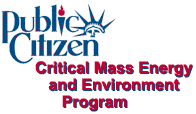

Commercial High-Level Nuclear
Waste:
A Problem for the Next 1000
Millennia
America's 103 nuclear power reactors generate radioactive waste that will remain hazardous for at least 1,000,000 years. Neither the atomic industry nor the federal government, which has actively promoted nuclear energy, have found any safe way of isolating the deadly waste from the environment for that period of time.
The Legacy
The highly irradiated nuclear waste contains many dangerous characteristics. A person standing one yard away from an unshielded, 10 year old fuel assembly, would receive a lethal dose of radiation (500 rem) in less than three minutes. A thirty-second exposure (100 rem) at the same distance, would significantly increase the risk of cancer or genetic damage. Plutonium, an element found within this waste is considered one of the most toxic wastes known to humankind.
The commercial reactors have generated approximately 40,000 metric tons of uranium (MTU) in radioactive nuclear waste. The Department of Energy (DOE) estimates that if all reactors operate for their full license term of 40 years, a total of 84,000 MTUs of nuclear waste will require disposition. Commercial high-level nuclear waste represents 95% of the nations radioactivity.
The Political Solution
The DOE is studying Yucca Mountain, Nevada, as a potential geological burial ground for radioactive waste. The federal government at the bequest of the atomic industry has historically supported the policy of nuclear waste disposition in a geologic dump. However, the Yucca Mountain dump demonstrates the failure of geological burial as a way to protect Americans health and safety. The industry drive to continue creating irrational deadlines as part of the nuclear waste policies of the DOE only worsen the situation. If Yucca Mountain is designated as the burial ground for nuclear waste in the future, it will cost taxpayers unimaginable amounts of money to clean up the long term environmental destruction.
Yucca Mountain is unsafe for many reasons, including fast water travel times, numerous earthquake faults, and volcanic activity. In fact, Public Citizen and 218 other environmental organizations petitioned the DOE to disqualify the mountain because DOE=s own models indicate that the site cannot safely shield the American public from radiation. Many other scientific studies have added to the concerns about Yucca Mountain. Extensive study of Yucca Mountain has only raised more problematic issues, which lead us to question the safety of forcing radioactive waste into the proposed repository at Yucca Mountain.
Transporting High-Level Nuclear Waste
Concern about the transport of nuclear waste is legitimate and raises multiple issues that must be resolved. Today=s transport casks are not full scale, physically tested. They are subjected to 1/4 scale model tests and computer simulation tests that do not represent real accident scenarios. Because we can be sure that accidents will happen, it is essential that all impacts are considered before concluding that shipping highly irradiated waste is safe.
A review of the hazardous materials release data from transport accidents demonstrates the potential magnitude of nuclear waste transport accidents. Department of Transportation records indicate that in a 10 year period there were 99,490 transport accidents releasing hazardous material. The accidents and subsequent releases caused 4305 minor injuries, 356 major injuries, 114 deaths, and $317,523, 997 in damages.
The final and most telling consequence of transporting high-level nuclear waste is described in an analysis by the DOE on the repercussions of a rural transportation accident. The study, part of the 1986 Environmental Assessment for the Yucca Mountain repository site, warns that a scenario involving a high speed impact, long duration fire, and fuel oxidation would contaminate a 42 square mile area, require 462 days to clean up, and cost $620 million. Is bailing out the nuclear industry worth the consequences of such an accident?
The Better Option
Sound scientific and environmental public policy dictate that we leave the waste on-site until our society can find a more credible option. While we do not advocate leaving the waste on-site permanently, we believe that significant time exists to establish a sound decision-making process, including public participation, to find a more credible option. The Nuclear Regulatory Commission has testified that on-site storage is safe for 100 years. While this length of time is disputable, we are confident that in the short term it is safer for the waste to be stored on-site, than for it to be hauled across the county to an unsafe site. We also strongly believe that before better options can be examined, a reclassification of the waste stream must be conducted. Dealing with the waste is an environmentally sustainable manner requires an honest look at the nature of the radioactive waste, the problems related to geological burial, and the consequences of transporting waste to a central repository.
Public Citizen's Critical Mass Energy
Project
215 Pennsylvania Ave., SE
Washington, DC 20003
Phone:
202-546-4996, Fax: 202-547-7392
cmep@citizen.org